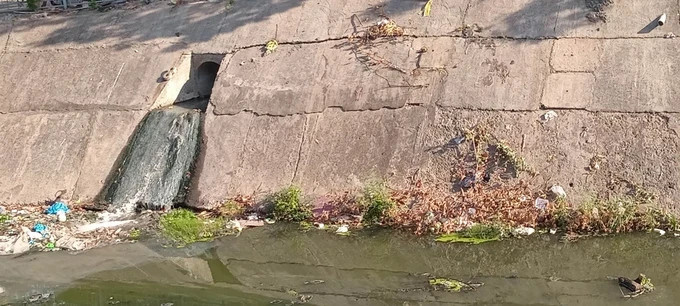
The drainage route of Cai Stream – Nhum Stream – Xuan Truong Stream – Ba Bo Canal (at the border between HCMC and Binh Duong Province) has been treated with various pollution mitigation measures.
Accordingly, Ba Bo Canal received more than VND1 trillion (US$39.44 million) for solid concrete embankment construction. Yet the canal water has always been too smelly. This is because many domestic wastewater pipes installed by local residents are pouring sewage directly into the canal.
A similar story can be found in Nhum Stream, whose water is constantly black and stinking from sewage of nearby residential areas.
Tran Van Dang, living near a bridge on Provincial Highway No.43 in Binh Chieu Ward of Thu Duc City sadly shared that he and his neighbors had hoped to have an improved living environment after the renovation of Ba Bo Canal. Nevertheless, the foul smell from the canal’s black water is still haunting them since domestic and industrial wastewater that has not been properly treated is continuously poured into the canal, severely affecting the health of dwellers here, especially the elderly and children.
Monitoring results of the Binh Duong Province Department of Natural Resources and Environment reveal that the water quality in the drainage route of Cai Stream – Nhum Stream – Xuan Truong Stream – Ba Bo Canal dropped slightly last year. Organic pollution still exists here due mostly to untreated sewage from households in Binh Hoa Ward of Thuan An City (Binh Duong Province) and near the dormitory of Vietnam National University – HCM.
According to the Vietnamese standards (QCVN 08-MT: 2015/BTNMT), in Ba Bo Canal, 75 percent of the locations do not satisfy the BODS parameter, 25 percent the DO parameter, 75 percent the COD parameter, and 100 percent the coliform one. The figures for Cai Stream – Nhum Stream – Xuan Truong Stream are all 100 percent, which is really worrisome.
Director Ngo Quang Su of the Natural Resources and Environment Department of Binh Duong Province shared that despite warnings of the local authorities against illegal waste disposal onto canals and efforts of functional teams to clean the surface of these canals, a large quantity of citizens, mostly street vendors and passersby, still throw garbage carelessly.
In addition, many households near Ba Bo Canal do not have their sewage pipes connected to urban sewage treatment plants owing to tardiness in the Nhum Stream drainage project as the land clearance task cannot be finished.
Deputy Director Nguyen Thi Thanh My of the HCMC Department of Natural Resources and Environment proposed that to reduce pollution on the above drainage route, HCMC is going to inspect law observation of local residents and businesses or factories sited nearby. The public land resource will be reviewed to allocate suitable locations for the installation of automatic monitoring stations in the bordering area between HCMC and Binh Duong Province.
Chairman of the People’s Committee of Binh Duong Province Vo Van Minh stressed that his province is going to increase its monitoring over Song Than 1 Industrial Park and Song Than 2 Industrial Park regarding sewage treatment tasks via monitoring camera systems, automatic monitoring stations, and automatic sample collection devices. It will also cooperate with the 4th Army Corps to identify sewage sources arisen from the unit’s operations.
Vice Chairman of the HCMC People’s Committee Bui Xuan Cuong shared that to protect the cleanliness of the bordering canal system between HCMC and Binh Duong Province, the city is going to inspect all possible sources pouring wastewater here and closely monitoring environment law observation of manufacturers and businesses as well as industrial parks along these canals.

The city assigns its Construction Department to continue the project to fight against urban flooding and to treat sewage in the 2020-2045 period, including accelerating the construction of Northern Saigon Wastewater Treatment Plant No.1, Northern Saigon Wastewater Treatment Station No.2. meanwhile, the municipal Department of Planning and Investment is directed to attract more investments in these two important facilities.
To address water pollution at bordering areas between HCMC and Long An Province, the HCMC Department of Natural Resources and Environment is requested to collaborate with its counterpart from Long An Province to develop a pollution control plan for the 2024-2030 period.
Accordingly, the two localities must strictly watch over pollution sources, share surface water monitoring data twice a month at bordering locations on Thay Cai Canal, An Ha Canal, Can Giuoc River, Ben Luc – Cho Dem River, as well as in industrial clusters and businesses normally releasing a large amount of sewage. These two are going to share inspection results and practical solutions while maintaining a special communication hotline for timely cooperation to handle law breaking cases.
The HCMC Construction Department is assigned to launch the Plan against Urban Flooding and Sewage Treatment in the 2020-2030 Period and the Project against Urban Flooding and Sewage Treatment in the 2020-2045 Period.
The Planning and Investment Department must promote investments in the construction of wastewater treatment plants, while the Agriculture and Rural Development Department is in charge of implementing regulations related to managing, exploiting, and protecting irrigation works for the Thay Cai – An Ha canal route.
The Irrigation Service Management and Operation One-Member Co. Ltd. is responsible for dredging sediment and collecting garbage for the above canal route.
Finally, the Urban Infrastructure Construction Investment Project Management Board is directed to speed up the construction of a wastewater collection system a corresponding treatment plant in the basin. The districts of Cu Chi, Hoc Mon, Binh Chanh, Binh Tan, and 8 are asked to update current wastewater sources under their charge and ensure all wastewater meets the applicable standards before being released into the environment.
SGGP